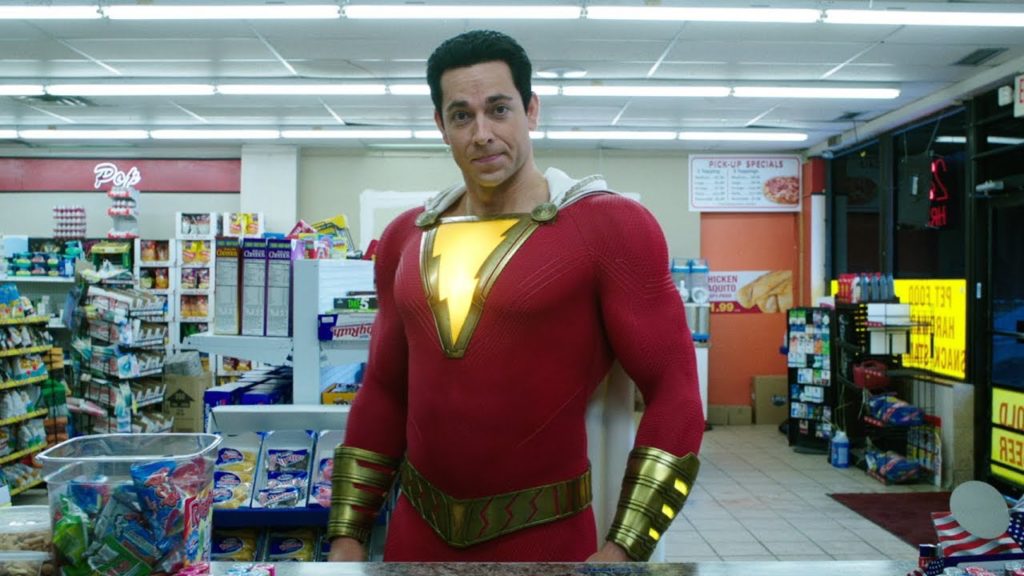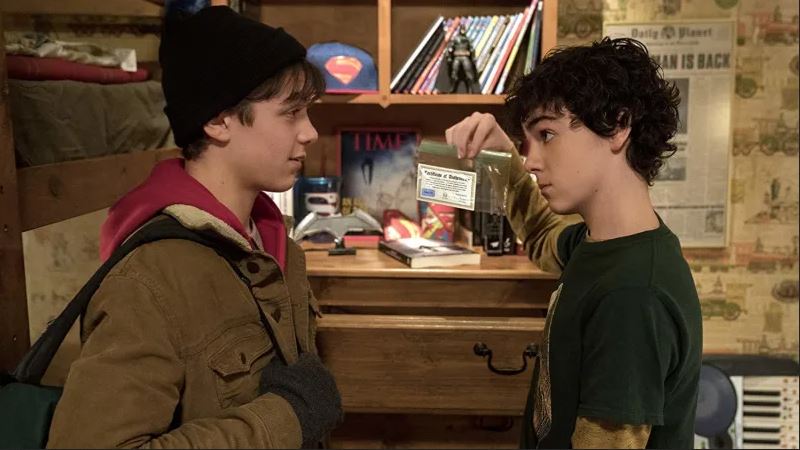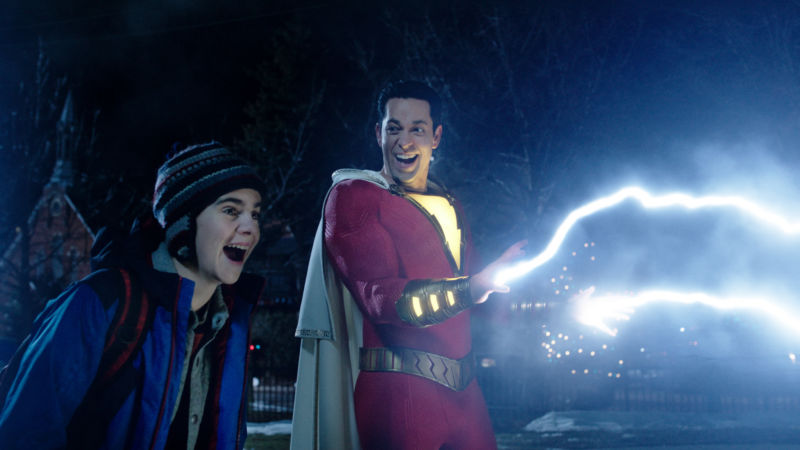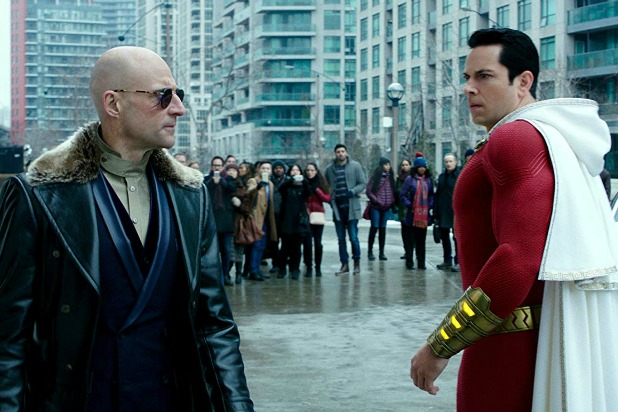
It’s been 14 years since Christopher Nolan made Batman Begins and changed superhero movies forever, ushering in an era of brooding protagonists, muted palettes, and weighty themes. Some of these solemn productions have been quite good, but in the wake of a glut of similarly aimed films that copied the darkness of the Nolan template but failed to capture its richness of character (to say nothing of the Briton’s spectacular execution), many comic-book fans have clamored for a return to lighter, more refreshing fare. Zooming into this void like a caped comet comes Shazam!, which may technically reside in the notoriously grim DC Extended Universe, but which really positions itself as just this sort of antidote, a bright and cheery corrective to the glum macho posturing of movies like Batman v Superman.
And if that’s all you care about, then this silly movie will surely satisfy you. Directed by David F. Sandberg from a screenplay by Henry Gayden, Shazam! is almost defiantly childish, and its goofball vibe can be disarming as well as irritating. But if you care about more than the film’s tonal blueprint—if, for example, you concern yourself with matters of writing, pacing, and action—then you are less likely to be amused. Shazam!’s commitment to lightness is laudable, but it seems to have confused being amiable with being, you know, good.
And in fact, the opening stretch of this movie is quite bad. Following an awkward prologue set in 1974, it flashes forward and alights on Billy Batson (Asher Angel), a morose teenager with a penchant for running away from foster homes. Friendless and hostile, Billy gets placed into a new home in Philadelphia, one of those quintessentially rambunctious houses where each child inhabitant has a single characteristic (the chatterbox, the neurotic, the fat kid, etc.). In narrative terms, the most important of his new roommates is Freddy Freeman (Jack Dylan Grazer, from It and Beautiful Boy), a superhero obsessive who is constantly yammering about other pieces of intellectual property in the DCEU and who becomes Billy’s closest companion seemingly by default.

The relationship between Billy and Freddy, which is designed to serve as the film’s emotional linchpin, instead proves to be one of its chief problems. Among Shazam!’s many platitudes is the importance of human decency, but Billy’s inevitable softening toward Freddy never really clicks, and their slow-developing friendship is too stilted to be convincing. Some of this may be the fault of the actors, but I’m more inclined to blame Gayden’s script, which as a general matter toggles between stale jokes and cornball clichés.
Billy’s perpetual exasperation is exasperating, which is why Shazam! improves markedly once he disappears, or rather, transforms. After an aged wizard with a magnificent beard (Djimon Hounsou, apparently on loan from the MCU) pops up to deliver the usual expository mumbo-jumbo—which here naturally comes in the form of a double entendre (“Lay your hands on my staff!”)—Billy transforms into a full-grown superhero, complete with bright red spandex, a white cape, and a yellow lightning bolt splashed across his chest. And because, in addition to operating as a jaunty comic-book movie, Shazam! is an earnest tribute to Big, Billy’s slight build and pinched frown have now been replaced by the broad shoulders and smiling mug of Zachary Levi.
Holy casting Batman! It’s been more than a decade since Levi gawkily loped onto television screens in Chuck (his big break before that was the multi-camera sitcom Less Than Perfect), and he’s spent the past few years gently rounding out his dweebish persona, landing appealing parts in The Marvelous Mrs. Maisel and Alias Grace. He’s always been an agile comic performer, but he’s never had a role as deliciously meaty as Shazam, which allows him to be buoyant, charming, and ridiculous. An adult actor pantomiming a teenager’s mannerisms is in some ways easy pickings, but Levi delivers a genuinely nimble performance; there are real smarts to his stupidity.

And Shazam! works best when pairing its goofy man-child with an actual child. A sequence where Shazam and Freddy attempt to buy beer at a convenience store, followed by Shazam casually foiling an attempted robbery, is executed with sharp comic timing. Later, a montage in which they methodically test the extent of Shazam’s lightning-wielding powers—which Freddy chronicles via smartphone footage that goes viral on YouTube—is full of wily visual gags. And if it’s somewhat frustrating that the movie expends considerable time on the duo’s hokey attempts to exact revenge on two numbskull bullies who torment Freddy—padding its unforgivable 132-minute runtime—such behavior is at least a reasonably honest depiction of how selfish teenagers might act when suddenly blessed with superpowers.
As a pure comedy, Shazam! is funny enough, but it also wants to work as both a sentimental crowd-pleaser and an action movie. It fails on both counts. The story features a runner about Billy searching for his biological mother, and while it culminates in a moderately affecting scene in a doorway, for the most part it’s obvious and cloying, with sappy speeches about friendship and family. Just because Shazam! is geared toward kids (a handful of legitimately violent moments notwithstanding) doesn’t mean its writing needed to feel so juvenile.
But if the film’s dialogue is amateurish, its action is downright terrible. Sandberg, whose previous two credits were for clammy horror pictures (Lights Out and Annabelle: Creation), seems uncomfortable working on this kind of scale, and he confuses light and sound with coherence and wit. Shazam! may be far more jocular than your average Zack Snyder joint, but aesthetically speaking, it borrows heavily from Snyder’s DCEU misfires. (The one noteworthy exception: a shot of Billy leaping off a roof into the night sky, his body catching a bolt of lightning and morphing into Shazam mid-flight.) There are lots of flashes of light and claps of thunder and people crashing through walls and windows; by contrast, there is very little that feels tangible, thus rendering the combat inert. And while there are a few memorable moments—an homage to the FAO Schwarz scene in Big; an ostensibly menacing speech drowned out by traffic noise—those work primarily as comic interludes, merely distracting you from the mundanity of all the punching, kicking, and throwing.

Much of this limb-waving is performed by Mark Strong, who plays the film’s villain, a disgruntled scion of an industrial empire with a glowing blue eyeball; he’s discovered a way to master the Seven Deadly Sins, which are here corporealized as swirling feline dust-clouds. (Look, it’s a comic-book movie, just go with it.) Strong could play this part in his sleep, which doesn’t excuse him sleepwalking through the part; he seems bored, and his disinterest drains his character’s battles with Shazam—whose original comic-book name was Captain Marvel (not to be confused with the other Captain Marvel currently flying around for the MCU)—of any remaining energy or suspense.
Before his fateful transformation into Shazam, Billy is told that only a person “pure of heart” may take up the hero’s magic mantle. Undeniably well-intentioned, the film leans into that phrasing, and as messages go, instructing children to be good is hardly a crime. But when it comes to making movies, purity is far from enough. Besides, just a few months ago, we were treated to Spider-Man: Into the Spider-Verse, the rare superhero picture that’s legitimately fun, visually dynamic, and genuinely exciting all at once. Shazam! tries valiantly to repeat the trick, but it never stood a chance. Lightning already struck the multiplex once.
Grade: C+
Jeremy Beck is the editor-in-chief of MovieManifesto. He watches more movies and television than he probably should.
